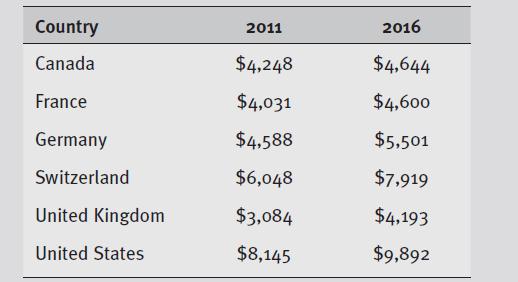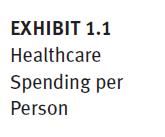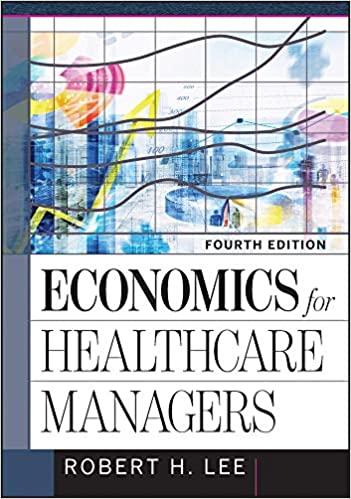Income is a possible explanation. Income per capita is higher in the United States than in the
Question:
Income is a possible explanation. Income per capita is higher in the United States than in the other five countries discussed in case 1.2 (World Bank 2017). This extra income could result in Americans’ using more services or paying higher prices. Part of the answer, it turns out, is that Americans pay higher prices. Americans use fewer pharmaceuticals, make fewer physician visits, and spend less time in hospitals but spend more on each of these items than residents of other countries do (OECD 2017).
Higher prices for inputs, such as pharmaceuticals, hospital services, and physician services, help drive higher spending in the United States. For example, the average amount private insurers pay hospitals and physicians for knee replacement surgery is $28,184 in the United States and $20,132 in Switzerland, whereas the National Health Service pays an average of $18,451 in the United Kingdom (International Federation of Health Plans 2016). Prices in the United States are 40 percent higher than prices in Switzerland and 53 percent higher than prices in the United Kingdom. Similarly, Harvoni, a drug used to treat hepatitis C, costs $32,114 in the United States versus $22,554 in Switzerland and $16,861 in the United Kingdom’s National Health Service (International Federation of Health Plans 2016). Prices for Harvoni in the United States are 42 percent higher than in Switzerland and 90 percent higher than in the United Kingdom. Most governments negotiate input prices, but in the United States private insurers with limited leverage negotiate prices. Governments in the United States do negotiate physician and hospital prices for Medicare and Medicaid, but not pharmaceutical prices.
The United States also has a more intensive mix of services. Compared with the average European country, the United States uses 88 percent more MRI (magnetic resonance imaging) scans per person, 76 percent more CT (computed tomography) scans, and 15 percent more cesarean sections (OECD 2017). In addition, the physician workforce has far fewer primary care physicians than in other wealthy countries. Although primary care physicians are well paid by international standards, earning an average of $217,000, this average salary is more than 40 percent less than specialists earn (Grisham 2017).
To understand the higher prices and more intensive service mix in the United States, one needs to understand the unique history of American health insurance. Blue Cross was started by hospitals in 1929 to bolster sagging hospital revenues, and Blue Shield was started by physicians in 1939 (Rothman 2017). Both were designed to limit price competition, and neither covered primary care services. Although health insurance is changing rapidly now, for many years the models set up by Blue Cross and Blue Shield persisted.
For the most part, Americans do not have worse habits than the citizens of other wealthy countries. Americans smoke and drink less than average (OECD 2017). Americans are much more likely to be obese than average, which contributes to high blood pressure, high cholesterol, diabetes, and a host of other complications. Increases in obesity have increased costs by hundreds of billions of dollars (Biener, Cawley, and Meyerhoefer 2017).
Discussion Questions
• Why are prices so much higher in the United States?
• Why is the intensity of care higher in the United States?
• Should Medicare negotiate drug prices?
• Why does the history of health insurance matter?
• How does obesity increase costs?
Case 1.1
The United States spends far more than other wealthy industrial countries but has poorer outcomes. Spending per person is more than double the spending per person in Canada, France, and the United Kingdom (see exhibit 1.1). Differences this large should be reflected in the outcomes of care.

However, of the six countries listed in exhibit 1.2, the United States has the shortest life expectancy at birth. In part, this difference is because the United States invests relatively little in improving the social determinants of health and reducing inequality. Adler, Glymour, and Fielding (2016) note that the life expectancy of 40-year-old men at the bottom of the income distribution is 14.6 years shorter than for men in the top of the income distribution. Greater spending should not produce these results.
Exhibit 1.2

Step by Step Answer:






